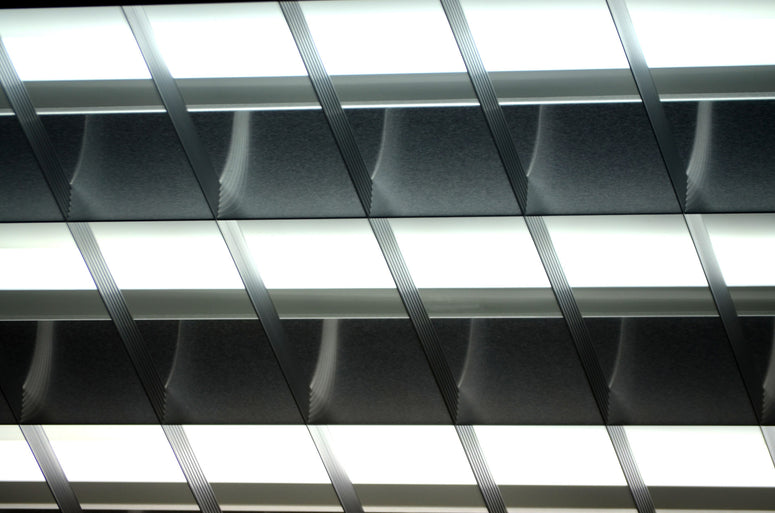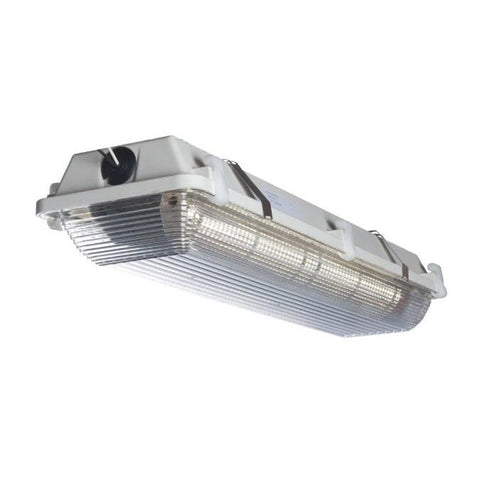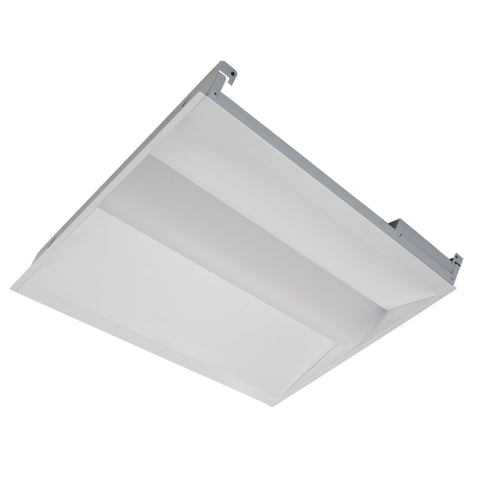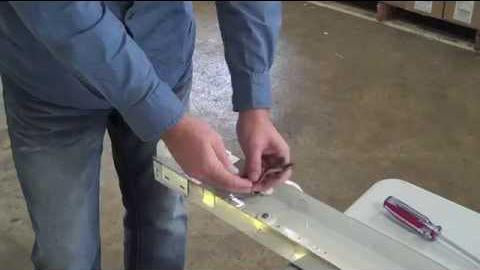LED vs Fluorescent Lights

A Comparison of LED Lights to Fluorescent Lights Across Common Lighting Applications
Many existing lighting fixtures still utilize fluorescent lamps, but in recent years, LED lighting has been found to be superior to fluorescent lighting in every way. This applies to fluorescent high bay lighting, vapor tight lighting and troffer lights. Here is how the comparison of LED to Fluorescent breaks down across several lighting applications:
High Bay Lighting Applications
What Are Fluorescent High Bay Lights?
In order to properly illuminate large indoor spaces with high ceilings (typically 20 to 40 feet from the floor), high bay lighting fixtures are required. Examples of such spaces are warehouses, factories, gymnasiums, department stores, and manufacturing facilities. Due to the distance between floor and ceiling, a high lumen output is required, and the light needs to be concentrated down and out from the fixture. These fixtures can be mounted directly to the ceiling or hung with chains, cables or hooks.
Fluorescent high bays would typically utilize linear lamps which were easy to replace when old ones would reach the end of their lifespan. Their benefits included cheaper cost, long life, and high efficiency. Their drawbacks included decreased lifetime if frequently turned on and off and they contained hazardous material in the form of mercury which made for waste disposal concerns at the end of its life. They also required a ballast in order to stabilize the light. LED lighting technology has developed to the point that it can overcome most or all of these drawbacks.
Why Are LEDs Better than Fluorescents for High Bay Lighting?
LED Provides Superior Color Rendering
Lighting quality is superior in terms of color rendering, color temperature and lumen output (compared to wattage used).
LED Have Longer Life Span
They have a much longer lifespan which means that the lights need to be replaced less frequently than other types. This is particularly important when it comes to high bay lighting which requires lifts or scaffolding to reach the fixtures.
LED Consume Less Energy
Although LED lighting is more expensive initially upon point of purchase, costs are more than made up in the long term due to the fact that they consume much less energy than conventional lights. This saves on utility costs over time. They also don’t waste energy emitted as heat.
LED Lights Are Omni Directional
Finally, the other types of lights listed above are omni-directional, which means that they produce a 360-degree output. With high bay light fixtures, the light needs to be directed down and out towards the floor. Much of this is wasted or needs to be directed using a reflector. LED high bay lights have a more concentrated light beam which means that nothing is wasted.
Vapor Tight Lighting Applications
What Are Fluorescent Vapor Tight Lights?
Designed to withstand areas where exposure to water, humidity or dust is an issue, vapor tight lights are made for indoor and outdoor applications. They are sealed and gasketed to protect internal components from harsh environments as well as rust and corrosion. These fixtures can come in 3 forms; high bay, linear and jar. High bay vapor tight fixtures are intended for use in applications where the fixture is mounted to ceilings at least 18 feet high and can provide more illumination over a larger area. Linear vapor tight fixtures typically come in 2, 4 and 8 foot lengths and can be mounted to ceilings, soffits or walls to provide a wide spread of illumination. Jar vapor tight fixtures are used to illuminate smaller spaces and can be mounted to walls, ceilings or hung as a pendant.
When shopping for a vapor tight fixture, it’s best to check what industry related certifications it has been rated at. Ingress Protection Ratings (IP) will tell you what the fixture is protected against such as water, vapor or dust. An NSF-rated fixture means it is approved for such areas as food service and restaurant supply facilities. Many of these fixtures utilize fluorescent lamps but in recent years, LED lighting has been found to be superior to fluorescent lighting in every way. The same applies to vapor tight lights. Here is how it breaks down.
Why Are LEDs Better than Fluorescents for Vapor Tight Lighting?
LED provides much better energy cost savings than Fluorescent
Typically, vapor tight fixtures utilize 1 to 4 fluorescent lamps per fixture. High bay and linear type fixtures require up to and above 160 watts for 4 foot fixtures (almost double that for 8 foot fixtures). For vapor tight fixtures with integrated LED, it is 12-55 watts for the entire fixture. This significantly reduces per fixture energy costs.
LED provides much better maintenance cost savings than Fluorescent
Within vapor tight settings, LED lights have a significantly longer lifespan than fluorescent. This means that there is less time spent maintaining the fixtures due to replacing the lamps. Unlike LED lights, fluorescent lights are affected by cold temperatures and constant on/off operations which can decrease lifespan. Less time required to maintain the fixtures means less maintenance costs.
LED provides much better lighting performance than Fluorescent
Fluorescent vapor tight fixtures have variable performance depending on the lamps used. T12, T8 and T5 lamps can perform wildly different depending on their manufacturer. Another issue is as individual lamps fail within a given fixture, its performance is compromised. Additionally, unlike LED, most fluorescent applications are not dimmable.
LED Provides Better Light Distribution
By contrast, LED vapor tight fixtures offer better light distribution, are available in a wider range of color temperatures and have higher color rendering.
Troffer Lighting Applications
What Are Fluorescent Troffer Lights?
Troffer lights (also known as recessed troffer lights or drop ceiling lights) are rectangular or square light fixtures that fit into a modular dropped ceiling grid. Some types can also be surface or suspension mounted to a ceiling. They are used in a wide variety of applications such as offices, retail spaces, warehouses, and classrooms. Standard sizes are 1’x4’, 2’x2’ and 2’x4’. Linear fluorescent lamps are commonly used in these types of fixtures such as T12, T8, and T5 lamps. These types of lamps are relatively inexpensive but since troffers typically use more than one lamp in each fixture, there can be issues with individual lamps which can lead to overall performance issues.
In recent years, LED lighting has been found to be superior to fluorescent lighting in every way. The same applies to troffer lights. Troffer fixtures are now available for use with LED T8 and T5 lamps as well as fully integrated LED arrays.
Here are the benefits of using LED lights within troffers.
Why Are LEDs Better than Fluorescents for Troffer & Drop Ceiling Lighting?
LED provides much better energy cost savings than fluorescent.
Common wattages used for each lamp for 4-foot troffer lighting are in the 28 to 40-watt range. Many 2’x4’ troffers use 4 lamps per fixture which equals up to 160 watts. For troffers with integrated LED, this range is 22-50 watts for the entire fixture. This results in a savings of up to $81 per 2’x4’ fixture, per year.
LED provides much better maintenance cost savings than fluorescent.
LED lights have a significantly longer lifespan than fluorescent. This means that there is less time spent maintaining the fixtures due to replacing the lamps. Unlike LED lights, fluorescent lights are affected by cold temperatures and constant on/off operations which can decrease lifespan. Less time required to maintain the fixtures means less maintenance costs.
LED provides much better lighting performance than fluorescent.
Fluorescent troffers have variable performance depending on the lamps used. T12, T8, and T5 lamps can perform wildly differently depending on their manufacturer. Another issue is as individual lamps fail within a given fixture, its performance is compromised. Additionally, unlike LED, most fluorescent applications are not dimmable. By contrast, LED troffer fixtures offer better light distribution, are available in a wider range of color temperatures and have higher color rendering.
Conclusion
In summary, LED is a superior choice for all of your lighting applications when compared to fluorescent lighting.

Condor Premium 2FT LED Linear High Bay Fixture, 85 Watt, 11560 Lumens, CCT Selectable 4000K/5000K, Comparable to 4 lamp T5, 6 Lamp 32W T8 or 250 watt HID

Condor Premium 2FT LED High Bay 155 Watt, 21080 Lumens, CCT Selectable 4000K/5000K, Comparable to 4 Lamp T5HO, 6 Lamp T8 or 320-400 Watt Fixture, 120-277v

8FT LED Vapor Tight Fixture, 15,000 Lumen Max, CCT and Wattage Selectable, 120-277V

4FT LED Vapor Tight Fixture, 7800 Lumen Max, CCT and Wattage Selectable, 120-277V

Shop High Bay LED Lights from Warehouse-Lighting.com. Our High Bay LED Lights offer superior illumination and efficiency, perfect for large industrial spaces.
View (280) Products
Vapor proof light fixtures are the top illumination choice for harsh environments. Available in multiple types, vapor tight led light fixtures provide ample illumination for indoor or outdoor applications. Shop vapor tight lights online at Warehouse-Lighting.com for the light to handle any job!
View (110) Products
Order troffer lights from Warehouse Lighting. Our troffer light fixtures are designed for energy efficiency and optimal illumination in commercial spaces, enhancing visibility and reducing energy costs. Shop troffer lights from Warehouse Lighting for reliable and innovative lighting solutions.
View (110) Products
Retro a Fluorescent Strip Fixture to LED
When it comes to saving energy and money with your lighting solutions, LED technology is the way to go. If you already have fixtures in place that you are looking to convert for energy-savings, ...
Watch Video
Difference Between T5 and T8 Low Bay Fluorescent Lighting Fixtures
Finding the right lighting solution for your location means comparing your options. When choosing between two types of lighting, there are many factors you may want to consider. For your l...
Watch Video
Retro a Fluorescent Strip Fixture to LED
When it comes to saving energy and money with your lighting solutions, LED technology is the way to go. If you already have fixtures in place that you are looking to convert for energy-savings, ...
Watch Video High Bay LED Lighting
High Bay LED Lighting
 Industrial Low Bay Lighting
Industrial Low Bay Lighting
 Industrial Strip Lights
Industrial Strip Lights
 Vapor Tight Lighting
Vapor Tight Lighting
 LED Shop Lights
LED Shop Lights
 Hazardous Area / Explosion Proof Lighting
Hazardous Area / Explosion Proof Lighting
 Loading Dock Lights
Loading Dock Lights
 Construction / Portable Lighting
Construction / Portable Lighting
 High Temperature LED Lights
High Temperature LED Lights
 Industrial Ceiling Fans
Industrial Ceiling Fans
 LED Work Lights
LED Work Lights
 Networked Controlled Lighting
Networked Controlled Lighting
 NEW Warehouse Lighting Fixtures
NEW Warehouse Lighting Fixtures
 American Made Industrial Lighting
American Made Industrial Lighting
 Clearance
Clearance
 Troffer Lights
Troffer Lights
 LED Flat Panel Lights
LED Flat Panel Lights
 Drop Ceiling Lights
Drop Ceiling Lights
 Suspended LED Lights
Suspended LED Lights
 LED Cylinder Lights
LED Cylinder Lights
 Exit / Emergency
Exit / Emergency
 Wrap Lighting Fixtures
Wrap Lighting Fixtures
 Gooseneck and Barn Lights
Gooseneck and Barn Lights
 Stairway & Corridor Lighting
Stairway & Corridor Lighting
 Hospital Bed Lights
Hospital Bed Lights
 Recessed Lighting
Recessed Lighting
 Wafer Lighting
Wafer Lighting
 RGB LED Lights
RGB LED Lights
 Grow Lights
Grow Lights
 Refrigeration Lighting
Refrigeration Lighting
 Commercial Sign Lights
Commercial Sign Lights
 LED Track Lighting Fixtures & Systems
LED Track Lighting Fixtures & Systems
 UV Disinfecting Lights & Air Purifier Fixtures
UV Disinfecting Lights & Air Purifier Fixtures
 American Made Commercial Lighting
American Made Commercial Lighting
 LED Flood Lights
LED Flood Lights
 Outdoor Wall Lights
Outdoor Wall Lights
 LED Area Lights
LED Area Lights
 Parking Lot Lights & Poles
Parking Lot Lights & Poles
 Outdoor Post Top Lights
Outdoor Post Top Lights
 LED Stadium Lighting
LED Stadium Lighting
 Canopy Lights
Canopy Lights
 Security & Motion Sensor Lights
Security & Motion Sensor Lights
 LED Bollard Lights
LED Bollard Lights
 Outdoor LED Linear Light Fixtures
Outdoor LED Linear Light Fixtures
 Solar Powered LED Lighting
Solar Powered LED Lighting
 Dusk to Dawn Lights
Dusk to Dawn Lights
 Landscape Lighting
Landscape Lighting
 Outdoor String Lights
Outdoor String Lights
 Coastal Wildlife Lighting
Coastal Wildlife Lighting
 Outdoor House Lights
Outdoor House Lights
 American Made Outdoor Lighting
American Made Outdoor Lighting
 Architectural Linear Lights
Architectural Linear Lights
 Architectural Grid Mount Lights
Architectural Grid Mount Lights
 Architectural Round Pendant Lights
Architectural Round Pendant Lights
 Architectural Square Linear Lights
Architectural Square Linear Lights
 Architectural X-Shaped Linear Lights
Architectural X-Shaped Linear Lights
 Architectural LED Wall Packs
Architectural LED Wall Packs
 Ceiling Fans
Ceiling Fans
 Ceiling Lights
Ceiling Lights
 Chandelier Lights
Chandelier Lights
 Pendant Lighting
Pendant Lighting
 Island Lights
Island Lights
 Under Cabinet Lighting
Under Cabinet Lighting
 Vanity Lights
Vanity Lights
 Wall Sconces
Wall Sconces
 LED Tape Lights
LED Tape Lights
 LED Mirrors
LED Mirrors
 LED Light Bulbs
LED Light Bulbs
 LED Tube Lights
LED Tube Lights
 LED Corn Lights
LED Corn Lights
 Vintage LED Bulbs
Vintage LED Bulbs
 Decorative LED Bulbs
Decorative LED Bulbs
 Fluorescent Light Bulbs
Fluorescent Light Bulbs
 Metal Halide Lamps
Metal Halide Lamps
 LED Magnetic Strip Retrofit Kits
LED Magnetic Strip Retrofit Kits
 LED Strip Light Retrofit Kits
LED Strip Light Retrofit Kits
 High Bay LED Retrofit Kits
High Bay LED Retrofit Kits
 LED Troffer Retrofit Kits
LED Troffer Retrofit Kits
 LED Wall Pack Retrofit
LED Wall Pack Retrofit
 LED Street Light Retrofit Kits
LED Street Light Retrofit Kits
 Recessed Lighting LED Retrofit Kits
Recessed Lighting LED Retrofit Kits
 Ballasts & Drivers
Ballasts & Drivers
 Emergency Ballast For LED & Fluorescent Lights
Emergency Ballast For LED & Fluorescent Lights
 Electrical Supplies & Mounting Kits
Electrical Supplies & Mounting Kits
 Electrical Tools
Electrical Tools
 Switches & Receptacles
Switches & Receptacles
 Electrical Power Cords
Electrical Power Cords
 Sensors and Timers
Sensors and Timers
 Smart Home Automation
Smart Home Automation
 High Bay Occupancy Sensors
High Bay Occupancy Sensors
 Electric Vehicle Chargers
Electric Vehicle Chargers
 Hand Dryers
Hand Dryers
 LED Shop Lights
LED Shop Lights
 Garage LED Light Fixtures
Garage LED Light Fixtures
 Office Lights
Office Lights
 Classroom Lights
Classroom Lights
 Church Lights
Church Lights
 Gym Lighting
Gym Lighting
 Factory Lights
Factory Lights
 Hospital Lights
Hospital Lights
 Walkway Lights
Walkway Lights
 Parking Lot Lights
Parking Lot Lights
 Exterior Building Lights
Exterior Building Lights
 Sports Lighting
Sports Lighting
 Airport Lights
Airport Lights
 NSF Rated Lights
NSF Rated Lights
 Restaurant Lights
Restaurant Lights
 Corridor Lights
Corridor Lights
 Barn Lighting
Barn Lighting






